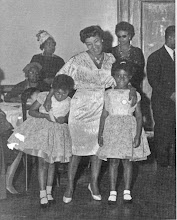This post originates at SOUL PICTURES:
http://mjsoulpictures.blogspot.com/2010/01/other-side-of-harlem.html
This blog has been devoted to interweaving the visual artifacts of my family, in particular the women, narratives and explanations of how they came about. In the process, one aspect of my family experience has been very consciously excluded: that of my father's family. It wasn't because I didn't or don't know my father's family or didn't know my father. It was rather because the rupture that took place between my father and mother's family when their marriage was annulled in 1956 was so profound and so unhealed even these sixty-five years later, that I conceived of the Soul Pictures project as solely a portrait of the transmission of culture via my maternal ancestry.
I thought to myself that I would leave my father's family to another time, a time when my focus on my father's family, their strengths and weaknesses, and the many photographs I have access to of them, would give less offense to the people who really raised me (in particular my stepfather Burdette) and took responsibility for me as a child.
But something very dramatic has happened since then related to this split between the maternal and the paternal sides of my legacy and ancestry. Also, some of the developments around the progression of the Soul Pictures project as a book about the women in my family has moved to the next stage, making it more conceivable to devote some space to my father's family in this blog afterall.
The dramatic thing that happened was the profile of Mom (Faith Ringgold) as part of a group of young people who began their careers as artists as children on Edgecombe Avenue, which recently appeared in the New York Times. Featured as a visual accompaniment to this article, is the multimedia presentation as part of the New York Time's new multimedia offerings at
http://www.nytimes.com/interactive/2010/01/22/nyregion/sugarhill.html
My father Earl Wallace, who was a classical and jazz pianist, was one of the young people who grew up on Edgecomb Avenue, at 365 Edgecomb Avenue in fact, and Edgecomb Avenue is where Earl and Faith first met and played together. His parents were from Jamaica, West Indies as were the two other people featured in the article about Faith. Both Roy Eaton and Cecelia Hodges were of West Indian ancestry and, no doubt, knew my father Earl.
Granted Earl didn't survive or become distinguished, as was probably true of many of their generation of both Southern and West Indian ancestry, but the main point I want to make is this: there were two distinctly different black migrations to New York which contributed substantially to the concentration of talent in the Sugar Hill section of Harlem in the thirties, forties and fifties when my Mom was a young woman.
There was a West Indian migration (from most of the islands of the Caribbean, of which my father's parents and extended family were part) and there was a Southern migration, which brought Faith's mother and father to Harlem. Both migrations were massive and both contributed substantially to the fame and cultural vibrancy of the area. Although the relative dimensions would be hard to determine since we rarely acknowledge the fault line between the West Indians and the Southerners.
At least if my family stories are any indication, and my own experience of having served as the only bridge along with my sister between the two families since we were infants, there wasn't a lot of love between the West Indians and the Southerners. Although I need to acknowledge here as well the efforts of my maternal grandmother, Momma Jones, Mme. Willi Posey, and her determination to foster our connections with my father's family. As a result of her efforts, I saw a great deal more of my father and his family than I think my mother has ever been aware of.
It is hard to tell how my family experiences relate to the larger picture for the area in general though but I do know a great deal about the ancestry of my father's family and this area mapped out as Sugar Hill in Harlem is precisely where they were then. Thanks to a meticulous family history (not formally published) including many photographs written by a cousin named Robert Tomlinson (an artist now who lives in France) on my father's side of the family, I have extensive information about the members of this family lineage and where in Harlem they were concentrated.
Of course, I think the story gets a good deal more interesting and instructive to current audiences if it is allowed to go beyond the production of the reputations of the people who became world famous and gets more into the historical and cultural particulars--the nature of their practices.
The list of people pointed out as having emerged to flower, or having lived in Sugar Hill, I find particularly frustrating and am hoping that it will simply be a beginning to which flesh and blood can be added over time. Chronologies and Maps are wonderful audio visual tools when the layers are allowed to build. All in all, I am so happy this happened.
And now I will tell you about my father's family because my father, my Mom and my stepfather were all very good friends on Edgecomb Avenue and the second marriage issued almost seamlessly from the first marriage. Unfortunately, my father died in 1966 when I was 14 and he was an only child but as an adult I have come to know that he had an interesting and accomplished family of origin. He, himself, got swept away by the plague of heroin addiction that settled upon the jazz community in the 40s and 50s and then branched out into a full scale plague by the 60s and 70s.





